Science, technology and innovation development. Рубрика в журнале - Economic and Social Changes: Facts, Trends, Forecast
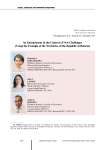
Статья научная
The aim of the work is to assess the activities of entrepreneurs in the regions of the Republic of Belarus affected by the Chernobyl disaster. We use statistical analysis and findings of sociological studies to assess entrepreneurial activity in the context of the following new challenges: the need to move to the sixth technological paradigm based on a highly competitive socio-economic system of a mixed type combining elements of state planning and market relations; preserving the social structure of the Belarusian society amid unprecedented wealth stratification in other countries; overcoming the consequences of man-made disasters. The empirical basis includes the data of sociological questionnaire surveys conducted in 2021 and 2022 by the Center for Social and Humanities Studies of the Belarus State Economic University in collaboration with the Institute of Sociology of the National Academy of Sciences of Belarus, within the framework of the research project “To carry out a sociological assessment of the entrepreneurial potential of the territories affected by the Chernobyl accident”. The findings of the research show considerable unity of moral and value priorities of entrepreneurs and the population. This reveals the degree of adaptability of the country’s socio-economic system to the challenges associated with the formation of a mixed economic model, in which elements of market management are new to Belarusians. We prove that entrepreneurs can be the vanguard of a mixed economy as the most competitive type for Belarus to shift to a society of the sixth technological paradigm, since they have qualities adequate to modern challenges: self-reliance, relying on one’s own capabilities, competencies, what everyone can do personally, on their own. One of the main advantages of business activity in Belarus is the low degree of cronyism, which helps to avoid the challenges of oligarchic capitalism and related unprecedented social stratification on a material basis. It is shown that entrepreneurs adequately assess the conditions for a successful start in various business areas. To a greater extent, a request has been formed to launch a business in the service sector, followed by the areas of specialized services - legal, medical spheres, production of goods, processing of products.
Бесплатно
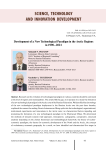
Development of a new technological paradigm in the arctic regions in 1990-2021
Статья научная
Research on the evolution of technological paradigms in various countries should be continued at the level of regions and municipalities. The article fills the gap, as its purpose is to study the formation of a new technological paradigm in the Arctic zone of the Russian Federation. We identified the chronology of the new technological paradigm deployment in the Russian Arctic over the past three decades; explained the reasons for making Nenets Autonomous Okrug a pilot site for technological, organizational, institutional experiments and innovations in the Arctic zone; we characterized factors impeding and promoting the formation of a new technological paradigm in the Murmansk Oblast. We determined the methods of research (system-wide approach, retrospective, cartographic, comparative, structural analysis) depending on the chosen theoretical and methodological framework: the theory of techno-economic paradigms, the theory for economic development of the North and the Arctic, the concept of evolutionary economic geography. As a result, we have identified and characterized five stages in the formation of a new technological paradigm in the Arctic in 1990-2021. We use the data on Nenets Autonomous Okrug to show the favorable role of small and medium-sized natural assets and the organizational diversity of extractive companies, an active policy of the regional government that pursues the principles of constructive duality at the first stage of the formation of the new technological paradigm. We also consider the data on the Murmansk Oblast to show the role of the resource monopoly of local large mining enterprises in inhibiting the entry of new actors and the deployment of new projects in the mining development of the region. We conclude that the formation of the new technological paradigm in the Arctic regions is characterized by significant unevenness (asynchrony): the susceptibility of the Arctic territory to the arrival of new actors, technologies and institutions is determined by the age of the resource province, type of natural resource, size and forms of location of the main deposits. The most important task for future research is to study optimal forms of state influence on the development of a new way of life in the territories of the Arctic with tools and institutions of active industrial policy at the federal, regional and municipal level.
Бесплатно
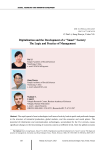
Digitalization and the development of a “smart” society: the logic and practice of management
Статья научная
The rapid spread of new technologies in all areas of activity leads to quick and profound changes in the structure of industrial production, global markets, and the economic and social sphere. The potential of information and communication technologies, accumulated by the 21st century, causes significant changes in the functioning of economic systems at different levels, from the global economy to individual economic entities; informatization and digitalization are the most important factors of economic growth. Under their influence, there is a transition from the introduction of individual digital technologies to the complex construction of a digital ecosystem. The rapid development of digital technologies has led to a model of society in which the real world and virtual space interact, a value orientation that combines big data algorithms with small data mining is emerging, a scenario spanning two opposing modes of decentralization and centralization is constructing, and different governance logics are emerging in which rule management and code-based regulation complement each other. This logic of governance has been put into practice in the process of social construction, creating an open and secure digital ecosystem, a collaborative multi-managerial circle and an inclusive dividend distribution circle, enriching the connotation of “co-building, co-managing and sharing”, thereby laying the scientific and technical foundation for modernizing the national governance system and management capacity. The aim of our work is to comprehend the concept, the essence of the term “smart society” in its relationship with the phenomenon of the economy digitalization and studying the practice of management of development of such a society. The scientific novelty and originality of the research is reflected in the development of theoretical and methodological approaches and conceptual apparatus of studying the essence of “smart society” in the context of the economy digitalization; in the development of scientific and methodological foundations of a comprehensive assessment of the state, development trends of “smart” society in the Russian Federation and China; in the formation of a set of practical measures and a list of indicators characterizing the development of “smart” society.
Бесплатно
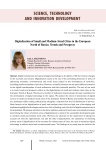
Статья научная
Rapid introduction and spread of digital technology in all spheres of life have lead to changes in the economy and society. Digitalization seems to be one of the promising directions in terms of addressing economic, environmental and social issues related to the development of territories, including small and medium-sized cities. However, scientific literature has not paid sufficient attention to the digital transformation of such settlements and their territorial specifics. The aim of our work is to study trends and prospects related to the digitalization of small and medium-sized cities in the European North of Russia. We present a number of indicators characterizing the basic conditions for the development of digital technology in the region. We analyze the extent of penetration of digital services in small and medium-sized cities of the European North of Russia and identify the presence of a developed online trading infrastructure alongside a relatively low level of distribution of services. Main barriers to the digitalization of small and medium-sized cities are high cost of developing and implementing digital technologies and services, lack of funding, and a low level of digital competencies in the population. We propose solutions to the above problems and put forward some conceptual provisions determining the choice of priority areas of digitalization to achieve the sustainable development goals in northern small and medium-sized cities. We focus our attention on the importance of taking into account not only the opportunities, but also the risks of digitalization; the expediency of choosing priority areas of digitalization of the economy for various types of cities; the need to introduce digital technology to address social and environmental issues. The findings of our study may be useful to the public authorities of RF constituent entities in finalizing regional strategies on digital transformation of economic sectors, social sphere and public administration.
Бесплатно
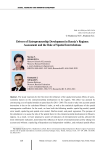
Статья научная
The study examines for the first time the influence of the spatial interaction effects of socioeconomic factors on the entrepreneurship development in the regions. This effect was assessed by constructing a set of spatial models on panel data for 2011-2019. The need to take into account spatial interaction is due to the calculated Moran’s index, as well as the statistical significance of the spatial autoregressive coefficient. In the work, we have built the following models: spatial lag model, spatial error model, spatial lag and spatial error model, Durbin model, and panel regression. The purpose of the simulation is to assess the role of the spatial factor in the entrepreneurship development in Russia’s regions. As a result, we have proposed a system of indicators of entrepreneurial activity, selected the most informative indicators, determined the influence of factors of entrepreneurial activity taking into account and without a spatial lag of dependent and independent variables, and evaluated spatial effects (direct, indirect, general). The article shows that the influence of wages and the unemployment rate on the change in entrepreneurial activity is much greater if spatial interactions are taken into account. The scientific novelty of the research lies in determining the degree and direction of the influence of spatial effects that have an impact on entrepreneurial activity and its factors. The results confirm the importance of using not only regional characteristics, but also spatial and temporal dependencies in the analysis of entrepreneurial activity. We expect that the research results will provide practical information to authorities and administrations seeking to promote the entrepreneurship development at the national level.
Бесплатно
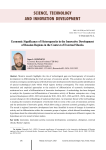
Статья научная
Modern research highlights the role of technological gaps and heterogeneity of innovative development in differentiating the level and pace of economic growth. This actualizes the analysis of trends in convergence and divergence of levels of innovative development of territories and the identification of special technological clubs within which regions develop convergently. The study systematizes theoretical and empirical approaches to the analysis of differentiation of economic development, understood as a result of differentiation of innovative development. A methodology has been designed to analyze the dynamics and differentiation of innovation activity of Russian enterprises over a long period of development (2010–2023 with details for 2010–2014, 2015–2018 and 2019–2023), taking into account changes in the methodology of statistical observation. An important feature of the methodology is tracking the innovative development of territories both in terms of the costs of innovation activities and the production of innovative goods, which allows using a common economic grouping of regions. The trends in regional innovative development have been identified in terms of changes in innovation activity and its differentiation within the economic groups of regions, which allowed formulating some hypotheses about the relationship between innovative and economic development of Russia’s regions; the hypotheses are to be tested in future studies
Бесплатно

Funding research and development in regions: tasks, current state, prospects
Статья научная
Financing the research and development sector is an important condition for growth of innovation activity in regions. However, the share of research and development (R&D) expenses in Russia has been decreasing over the last ten years. According to this indicator, Russia lags behind other countries - leaders of innovation development 3-4 times. The formation of funds to support research, scientific and technological, and innovation activities can contribute to the growth of the volume of R&D financing. The purpose of the study is to examine the organizational conditions for the formation of funds to support research, scientific and technological, and innovation activities. Using statistical data from Rosstat, we calculated the variants of growth of R&D costs provided that regional funds are created, the budget of which is formed by deductions from the revenues of organizations in the amount of up to 1.5%. We have identified groups of companies whose financial resources could be a source of formation of the funds budget. The article identifies the main directions and volume of use of finances accumulated in the funds. In the final part of the article we reviewed the support measures for companies that participate in filling the budget of the funds, and proposed adjustments to the main areas of incentives for organizations. The scientific novelty of the presented work lies in the implementation of a comprehensive study of the supporting funds for research, scientific and technological, and innovation activities in the RF constituent entities as a tool for the growth of R&D expenditures. The latter includes studying the issues of financial filling of the funds budget, determining the directions and calculating the possible volume of spending of accumulated funds on them, as well as adjusting the existing measures to encourage organizations to participate in financing the funds budget. The practical significance of the work lies in the fact that its results can serve as an economic justification and organizational support for the creation of regional funds by regional authorities. In addition, the materials of the study can be used to develop a separate federal law regulating the creation and operation of the funds in question.
Бесплатно
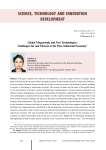
Global Megatrends and New Technologies: Challenges for and Threats to the Post-Industrial Economy
Статья научная
The paper considers the influence of megatrends, currently acting as drivers of changes taking place in society, on the structure of the emerging economy of post-industrial society. Under their influence, a new economy is formed, focused on the use of such a resource as time, the amount of which, available to people, is increasing as robotomics develops. The research is based on the study of five global trends in the development of modern society: demographic transformations; natural resources depletion and climate change; changing geo-economic and geopolitical landscapes; digitalization and development of new technologies; comprehensive human welfare: wealth, health and knowledge. The article proves that these trends seriously challenge the future of humanity and fundamentally change the structure of the economy and employment. The response to the megatrends challenges is the formation of new directions in the economic structure that help to respond to them and deal with their negative implications. We establish that megatrends have contributed to the development of such areas as silver economy, circular economy, robotomics, peer-to-peer economy, and laid the foundation of a spiritual and moral economy and leisure economy. The work concludes that there are prerequisites in society for the transition to the economy, in which social effects will prevail over economic ones. High level of technology development and digitalization help to make such a transition to an “economics with a human face”. The formulated principles of adaptation to the emerging economy enable countries to develop a transition strategy with minimal social and economic costs. The novelty of the research consists in comparing megatrends with changes occurring in the structure of the economy and the labor market, as well as in substantiating social orientation of the post-industrial economy, which is formed under the influence of global trends in social development.
Бесплатно
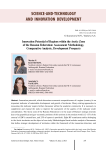
Статья научная
Innovation potential, which determines economic competitiveness of a region (country) is an important indicator of sustainable development and growth of territories. Many existing approaches to measuring this indicator require further discussion within the academic community. It is necessary to supplement and expand the tools to improve the assessment of the quality of the indicator under consideration. The Arctic zone of the Russian Federation is in the scope of Russia’s strategic interests due to the geopolitical and geo-economic positions of this territory in the modern world (12-15% of the country’s GDP is created here, and 25% of exports is provided). Eight RF constituent entities belonging to the Arctic territories are the object of our study. Methodological basis includes analysis of documents that define strategic development of territories within the framework of the innovation direction, and review of existing approaches to assessing innovation potential level. Regional statistical data serve as the information base. The aim of the research is to develop a methodology for assessing innovation potential using objective indicators grouped into blocks and calculated using the integral method. The results are visualized on a radar chart that contains indicators for the regions included in the RF Arctic zone. This makes it possible to compare RF constituent entities according to the degree of innovation potential and determine their position. We suggest clustering regions, identifying leaders and outsiders so as to substantiate proposals to stimulate key areas in innovation activity. We provide an interpretation of the values of innovation potential level. The findings of the research indicate the necessity to design programs for regional development of territories with the involvement of large business as a potential investor.
Бесплатно

Innovation processes staffing: Issues and content
Статья научная
In the context of global competition and geopolitical challenges, the issues of outstripping innovative development and achieving technological sovereignty have become particularly relevant for Russia. Innovative development largely depends on an effectively functioning national innovation system, and technological sovereignty is ensured not by innovations themselves, but by highly qualified specialists capable of generating and implementing breakthrough ideas. An analysis of the trends in the development of artificial intelligence technology, a most relevant innovation of our time, allows us to conclude that there are certain barriers in the interaction of elements of the national innovation system regarding the provision of human resources for the development of this technology. The existing scientific groundwork in this area does not have a formalized theoretical and methodological framework for addressing this problem. The aim of our research is to design the conceptual foundations for staffing innovation processes in the context of Russia’s national innovation system. Based on the consideration of various points of view on the interpretation of key categories of innovation theory, the article offers a conceptual scheme of their relationship; we formulate our own definition of innovation processes staffing and disclose its content within the framework of Russia’s national innovation system. Using the example of artificial intelligence as one of the key innovations, we identify categories of human resources necessary for various stages of the innovation process. Based on the findings of the study, we propose a comprehensive scheme for staffing the innovation process in the context of the Russian national innovation system, where, together with its traditional elements (business; universities and academic structures; the state), society is considered as an important component of staffing innovation development. Taken together, the results obtained make it possible to formalize innovation processes staffing as a scientific category and define the general outline of this process, which needs further elaboration and development.
Бесплатно
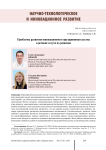
Innovative entrepreneurship development in the region: challenges and ways to address them
Статья научная
The entrepreneurship sector in a market economy is becoming a major driving force of innovative development. This is due to the fact that in a competitive environment, in order to maximize profit growth, an entrepreneur is forced to produce a more complex and innovative product. Thus, entrepreneurship is an “accelerator” of innovation activity. In this regard, special attention has recently been paid to the activities of innovative entrepreneurship. Research findings allowed us to conclude that at the moment there are a number of issues that hinder the development of innovative organizations. Accordingly, the presence of such challenges impedes innovative economic development. It is especially important to identify these problems at the present time, when innovation has become one of the main national priorities. The aim of the work is to identify problems in innovative entrepreneurship development at the regional level and find ways to solve them. The research methodology involves using various scientific techniques: from general scientific to narrow ones. Special attention is paid to economic sociology methods (expert survey). Scientific novelty of the research consists in the development of tools that help to identify problems in the development of innovative organizations at the regional level. Practical significance lies in the fact that on the basis of the challenges identified, we propose directions to address them, which can be adopted by representatives of regional authorities in order to improve the innovation policy pursued in the region.
Бесплатно
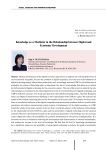
Knowledge as a mediator in the relationship between digital and economic development
Статья научная
Modern development of the digital economy urges society to address not only the global issue of socio-economic inequality, but also the problem of digital inequality, since the level of development of digital technology largely affects labor productivity and, accordingly, national GDP. In this dichotomy of inequality, the sphere of knowledge plays an important role, since it is knowledge that allows us to unlock the full potential of digital technology for the economic system. The aim of the work is to identify the role of knowledge as a mediator in the relationship between the level of development of digital technology and GDP in different countries. The study used data from the Global Knowledge Index, Network Readiness Index and Digital Competitiveness Ranking in their relationship with GDP per capita. We analyzed the results of two models containing data sets for 64 countries for five years and 134 countries for three years; thus, we revealed the influence of the digital competitiveness and network readiness indices, as well as their constituent sub-indices characterizing certain aspects of development of the digital economy, on GDP. Scientific novelty of the study consists in the fact that it reveals the absence of the influence of knowledge on the relationship between GDP per capita and the penetration of digital technology into the national economy. We prove that indicators based on the spread and penetration of technology into the economy cannot objectively reflect the possibilities of economic development in the process of digitalization. It is necessary to focus on indicators reflecting the development and dissemination of national technologies; this requires an increase in the level of knowledge. We find that the level of knowledge development has a significant impact on the possibility of using digital technology to achieve the goals of sustainable development and organize effective management of digitalization. Otherwise, the impact of digital technology on economic development will be much less than the potentially possible level. The results of our study can be used by national governments to develop a strategy to overcome the digital divide and bridge a socio-economic gap between countries.
Бесплатно
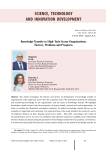
Knowledge transfer to high-tech sector organizations: factors, problems and prospects
Статья научная
The article investigates the features and drivers of development of knowledge transfer to organizations of the high-tech sector from the academic sector. We systematize methods for obtaining and transferring knowledge by the organization, and the types of knowledge transfer. We highlight knowledge transfer factors from the perspective of process-based, network and system approaches. In order to confirm the theoretical conclusions obtained, we analyze knowledge transfer factors on the example of a large high-tech enterprise. The empirical basis of the study includes the results of a survey of employees (Rostov-on-Don, Russia) carried out in April - May 2023. According to the results of the questionnaire survey, we carry out correlation and regression analysis to establish actual relationship between the factors characterizing the parameters of knowledge transfer from the academic environment. It is shown that all groups of factors have a direct positive impact on the results of knowledge transfer. At For citation: Flek M.B., Ugnich E.A. (2023). Knowledge transfer to high-tech sector organizations: Factors, problems and prospects. Economic and Social Changes: Facts, Trends, Forecast, 16(5), 83-100. DOI: 10.15838/esc.2023.5.89.5 the same time, it is emphasized that the factors such as the recipient of knowledge, knowledge providers and mutual trust of the transfer participants, that is, the factors characterizing the internal motivation of the participants, have a stronger impact on the result of the knowledge transfer as compared to the factors like the organization of interaction, which reflect external motivation. According to the conclusions obtained, we put forward some recommendations aimed at improving the effectiveness of factors affecting the transfer of knowledge to an enterprise. There are five main directions for the development of knowledge transfer: improving the efficiency of organizing the interaction between the supplier and the recipient of knowledge; strengthening the level of trust between them; expanding the circle of knowledge providers; increasing their ability to transfer knowledge and the ability to perceive new knowledge by the recipient, increasing the effectiveness of the application of acquired knowledge. We emphasize the importance of the professional and educational ecosystem as an open non-hierarchical stable relationship of the enterprise with educational, scientific, and nongovernmental organizations in the development of knowledge transfer.
Бесплатно
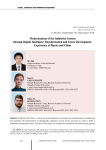
Статья научная
In Russia and China, a course has been outlined to accelerate the transformation of traditional and stimulate the development of strategically important sectors of the economy in order to build a modernized industrial system. The aim of the study is to explore the possibilities of modernizing regional industrial systems in the Vologda Region and Jiangxi Province from the perspective of digital transformation and green development. To achieve this goal, tasks such as analyzing the state of the regional industrial systems of the designated regions, studying the directions of their modernization, and proposing measures to facilitate this process were solved. In traditional sectors of the economy, the processes of transformation and integration of the real and digital sectors of the economy are accelerating. At the same time, the promotion of the synergy of digital intellectual transformation and green growth is hindered by the weak competitiveness of industries concentrated in the middle and lower links of regional value chains, the lack of necessary technologies, and uncertainty in value chains. In order to overcome these obstacles, it is important to form industrial clusters in promising sectors of the economy, focus on the development of traditional industries, encourage enterprises to use scientific and technological achievements in production, introduce digital platforms, and apply a number of measures aimed at accelerating the integration of the real and digital sectors of the economy. The novelty of the conducted research lies in identifying trends in digital intellectual transformation and green development of regional industries, as well as in forming a set of measures that contribute to the activation of these processes. The information base of the study was made up of data from the Federal State Statistics Service and the National Bureau of Statistics of China, as well as foreign and domestic research in the field of industrial system modernization. The results of the study can be used by regional authorities in the development of strategic documents to substantiate the directions of economic policy
Бесплатно
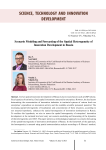
Scenario modeling and forecasting of the spatial heterogeneity of innovation development in Russia
Статья научная
Uneven spatial innovation development of Russia is due to many factors such as GRP volume, fiscal capacity of territories, fixed capital investments attracted by enterprises. However, the key factors determining the concentration of innovation industries in territorial systems of various levels are enterprises’ expenditure on innovation activity and the available scientific personnel potential. The increasing spatial heterogeneity of localization and concentration of these resources, according to our research hypothesis, enhances the spatial heterogeneity of innovation development in Russia. To confirm this hypothesis, we aim to assess the spatial heterogeneity of enterprises’ innovation development at the national level and carry out scenario modeling and forecasting of the dynamics of this heterogeneity until 2025. The paper presents a methodological approach to scenario forecasting of the spatial heterogeneity of innovation development of Russia. In the framework of the approach, the heterogeneity is assessed using spatial autocorrelation analysis according to P. Moran’s method, regression analysis of the dependence of the volume of shipped innovation goods and services performed on the costs of innovation activities carried out by enterprises, and the number of research personnel in the regions, as well as autoregressive analysis of the dynamics of their changes using a moving average (ARIMA modeling) to form the most likely forecast scenarios of innovation development for different groups of regions. The novelty of the approach lies in the system-wide use of spatial autocorrelation analysis methods based on various spatial weight matrices, regression analysis methods based on panel data and ARIMA modeling, which in combination with each other make it possible to determine the degree of influence of the factors on the heterogeneity of innovation development in regions and to form a system of various forecast scenarios. The results of the study will serve as the basis for the formation of Russia’s innovation framework. The constructed forecast scenarios will help to form strategies for innovation development in Russian regions, taking into account the identified features of the spatial localization of factors that have a significant impact on innovation development.
Бесплатно
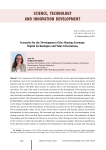
Scenarios for the development of the sharing economy: digital technologies and value orientations
Статья научная
The expansion of the sharing economy is related both to the rapid technological and digital development and to the transformation of behavioral patterns based on the development of network relations and the search for new forms of cooperation. However, the scenarios for the spread of this economic system will differ from country to country due to the heterogeneity of socio-economic conditions. The aim of the study is to identify scenarios for the development of the sharing economy, taking into account technological and value characteristics of a territory. The methodology of this study includes correlation and regression analysis, systematization methods, descriptive statistics, and graphical method. The information base for the study is data from the Timbro Sharing Economy Index, the World Bank, and the World Values Survey. As part of the research, we formulated and tested hypotheses on the impact of digital development and values on the development of the sharing economy. We show that the key factors in the development of the sharing economy are the level of digital technology as well as postmaterialist values. In the course of the study we identify and describe clusters of countries distinguished by these parameters. We formulate and describe scenarios for the development of the sharing economy. We reveal that these scenarios differ not only in the level of development of digital technologies and the readiness of citizens to use services of the sharing economy, but also in the scale of the territory to which the principle of collaborative consumption applies. Theoretical significance of the obtained results consists in modeling the development of the sharing economy and forecasting possible directions of its development. Practical significance is the application of these scenarios in the formation of urban infrastructure or the design of smart cities.
Бесплатно

The impact of R&D expenditures on high-tech product exports
Статья научная
Increasing high-tech product exports in international markets to achieve sustainable economic growth goals is considered an important element in every country in the contemporary world, where globalization is experienced at the highest level. Although it is accepted that many factors affect high-tech product exports in the literature, it is emphasized that R&D expenditures have significant effects. In this research, the effect of R&D expenditures on high-tech product exports in 11 emerging market economies in the period of 1996-2018 was examined. In the context of explanatory variables that are thought to have an impact on high-tech product export, exchange rate, foreign demand, economic growth, and foreign direct investments were used in addition to R&D expenditures. To analyze the relationships, panel quantile regression analysis was applied. The results showed that each variable had different effects on high-tech product exports, and it was seen that R&D expenditures had a positive and very strong effect. In addition, it was determined that economic growth and foreign direct investment also had positive and significant effects on high-tech product exports. In the light of the findings, it is of great importance to allocate more share to R&D expenditures to increase high-tech product exports and benefit from international trade markets more effectively, especially in developing countries.
Бесплатно
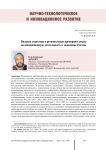
The specific structure and regional proportions of innovation costs in the Russian economy
Статья научная
The most important choice of a company in the implementation of innovative activities is the decision on the method of mastering new technologies. There is a distinction, first of all, between the development of technologies through their research and through their operation. The assessment of the ratio of these two methods of technology development in the economy of Russian regions has significant research potential. The study implements a methodology for comparative analysis of the spatial dynamics of various types of innovation activities, which allows overcoming the methodological limitations of official statistics. The coefficients of elasticity according to the time trend for the total costs of innovation activities, including research and development costs, costs for the purchase of machinery and equipment, and costs for industrial design (engineering) and design by groups of regions of Russia in 2011-2015, 2016-2018 and 2019-2022 were obtained. The results of the study detail the trends in the innovative development of groups of regions in 2011-2022 with a specification of the dynamics in the pre-sanctions and sanctions periods. It has been established that the systematic development of technologies through their research was carried out mainly in the pre-sanctions period and only in the most developed regions. During the period of increasing sanctions pressure, research and development are localized in metropolitan centers, and remote and underdeveloped regions begin to systematically master new technologies through the purchase of machinery and equipment, as well as industrial design (engineering) and design. The system of econometric estimates obtained in the study, which takes into account both the economic specifics of innovations and the methodological problems of their statistical accounting, made it possible to specify
Бесплатно

